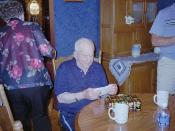Professor Lehman
Humanities 110
October 13, 2003
Scarface (1983)
The 1983, Brian De Palma, remake of Scarface has its very own unique visual style. He used multiple images and many other visual motifs to form patterns and give thematic meaning to the film.
The use of multiple images, closely related to split screen cinematography, is characteristic of De Palma's films. In this film he used mirrors and television monitors to give more than one image within one screen. The way he used these multiple images is an example of a free motif. The use of mirrors was common in the booths at the Babylon Club. By using these mirrors it was possible to see multiple images while the camera was focused on one person. When two men attempt to murder Tony Montana, while he was sitting in the booth, the mirrors show the stage character performing in the background.
The more common example of multiple images was that of the surveillance monitors as well as the television, in the same screen. One of the shots showed Tony in the bathtub smoking a cigar. He was watching the television and it showed the four other surveillance monitors. Another shot showed Tony sitting in his big chair, with a mountain of cocaine on his desk. Behind him it showed the six surveillance monitors with an army of guys running through one of the screens.
A bound motif that was very evident throughout the film, was the connection between Tony and his sister Gina. The first time they are shown together, they give each other a hug that would not be common between brothers and sisters. They are holding each other very close, she put her hands on his head, then fixed his collar. He then gave her a heart necklace.


